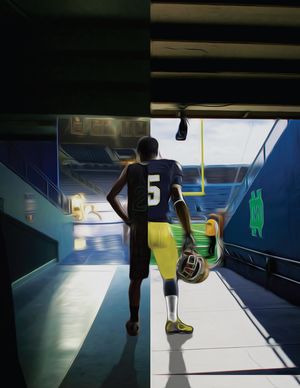 "
"
The parable of the prodigal son is likely a familiar story for much of the Notre Dame community. The son squanders his inheritance and begs for forgiveness, and the father welcomes his son home with compassion and a joyous celebration. The younger son, who has stayed home and worked hard during his brother’s absence, questions why the celebration is not for him, but his father says he must rejoice for his brother’s return. It’s the type of redemption story that strikes a chord with all who have erred and sought forgiveness in their lives.
This year, two of Notre Dame’s highest-profile students, Everett Golson and Jerian Grant, have drawn comparisons to the prodigal son. One group of students has even sold shirts with “RETURN of the PRODIGOL5ON” printed on the front.
Golson and Grant both received suspensions from the university last year due to academic issues, costing Golson the entirety of his sophomore football season and Grant the majority of his junior basketball season. As arguably the most important players on the most popular teams at Notre Dame, Golson and Grant’s departures were devastating to their respective teams.
Playing quarterback in 2012, Golson threw for 12 touchdowns, ran for 6 and helped the Irish reach the national championship game. His loss was sure to take a toll. Without Golson, Coach Brian Kelly’s squad had an up-and-down 2013 campaign and finished with a 9-4 record.
Grant came into the 2013 season as the Irish’s main scoring option. He started exceptionally, averaging 19 points per game on 52 percent shooting before his suspension was announced. The Irish had a record of 8-4 at the time and struggled to transition to the ACC without their leading scorer. The team finished the season with a record of 15-17, the program’s first losing season since 1998- 1999.
Do students and other members of the Irish family still harbor resentment towards these players for the circumstances surrounding their suspension? Did these players need to be forgiven by the Notre Dame community? What is the appropriate reaction to their return?
The Team
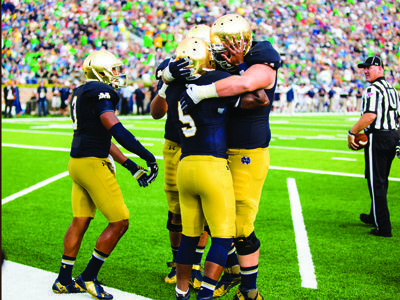
It should come as no surprise that many have already welcomed Golson and Grant back into the Notre Dame fold. Throughout the sports world, gifted athletes are given a second chance. Whether it’s Michael Vick winning the 2010 NFL Comeback Player of the Year after serving prison time for dogfighting or Tiger Woods returning from an infidelity scandal to win the 2013 PGA Tour Player of the Year, athletes who make amends for their misconduct are typically afforded the opportunity to redeem themselves on the field of competition.
Some of the most enthusiastic supporters of Golson and Grant’s returns have been their teammates.
“We’ve welcomed Everett back with open arms,” senior running back Cam McDaniel says. “He’s a tremendous player; he’s a tremendous guy... We look forward to having him back on this team.”
Offensive lineman Christian Lombard expressed similar sentiments. “I don’t think anyone hasn’t accepted him,” he says. “He’s Everett. He’s an outgoing, great guy. We all love him. He messed up, and we understand that. Nobody’s perfect. It’s great to have him back.”
Notre Dame senior forward Pat Connaughton is thrilled to have Jerian Grant back with the team.
“There was just one thing missing from those close games [last year]...We had guys that may not have played up to their potential in some games, and that’s where Jerian has always been solid. He’s never going to hurt you in any way.”
Sophomore guard Demetrius Jackson praises Grant’s leadership skills. “I look up to Jerian; I’ve learned a lot from watching him and listening to him speak. I’m going to learn from him this year and hopefully we can continue to work hard and have a good year,” Jackson said.
This positive reaction from teammates is not surprising to Notre Dame sociology professor Jessica Collett, Ph.D. “Athletes are lucky when it comes to returning to a group because the things that enhance trust, likability, forgiveness and these positive relational outcomes have to do with contact,” she says. “Sports teams are always working out together. They’re playing games together. They live together in houses. So there are all kinds of contact, and it’s a nice way for people to get reintroduced into a group.”
No one knew exactly how Golson and Grant would be received upon their returns to Notre Dame. But they both are appreciative of their reception thus far.
“I haven’t really gotten any animosity or anything,” Golson says. “Everybody just kind of greets me with a smile, and it’s ‘glad you’re back,’ that type of thing... [This is] your family, that close-knit community. That’s one of the reasons that I came back, is because of that family feel here.”
Grant says his teammates have been instrumental in making him feel at home again at Notre Dame. “Since the day I got back, the guys are like ‘Jerian, you’re back, you’re our leader now, so here you go,’” Grant said. “It really meant a lot for me for them to do that.”
He asserted that much of the reason he returned was to remedy his absence last year. “I have unfinished business here…I haven’t finished the goals I set for myself coming here,” Grant says.
The Media
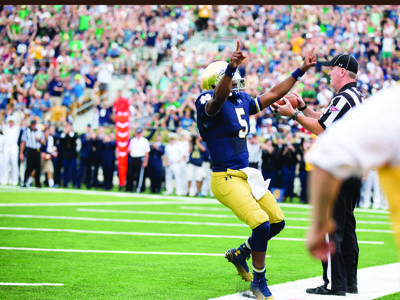
The media’s reception of Grant has been largely positive so far. Late in July, the studentrun television video channel from Fighting Irish Digital Media (FIDM) and Notre Dame Athletics released a three-part video series entitled, “Jerian Grant Returns.”
The series begins with Grant’s “fall from glory,” as it recaps his final game before serving his suspension, a heartbreaking loss to Ohio State in December 2013. After describing Grant’s anger at the suspension, the video segues into Jerian’s teammates and Coach Mike Brey commenting on how much Grant means to the team and how important it was for him to decide to return. The series describes how hard the suspension was for Grant and the ways in which he stayed involved while he was away from the team.
At the end of the video, Grant affirms his belief that everything happens for a reason and says the suspension could end up being the best thing that ever happened to him. The clip fades out with Grant walking away from the Main Building, the Golden Dome shining over his head.
This video series is a clear example of Notre Dame media embracing Grant’s return, forgetting his past transgressions and focusing only on his future potential for greatness. Grant says he has found a new balance between basketball and class since returning. “I’m just more focused on getting my work done,” he says. “Being able to balance both is definitely something I’ve been focusing on.”
The media’s reception of Golson has also been very positive upon his return. Although Golson’s suspension brought criticism of both his academic and athletic abilities, the media has been eager to jump on the redemption angle since his return.
Bleacher Report published an article by Notre Dame football writer Keith Arnold the week the Irish prepared to face Michigan entitled “Everett Golson Redemption Story Riding On Michigan Game.” The article acknowledges Golson’s impressive performance against Rice, but argues he has a lot to prove as a quarterback, citing his struggles during the 2012 season.
“For Golson’s redemption story to be complete, he needs to help Kelly slay a dragon (Michigan) that’s taken three of four from him since he arrived in South Bend,” Arnold says in his story. Golson answered the call and delivered in spectacular fashion, tossing three touchdowns en route to a 31-0 blowout victory. The redemption story continued to gain strength.
The Community
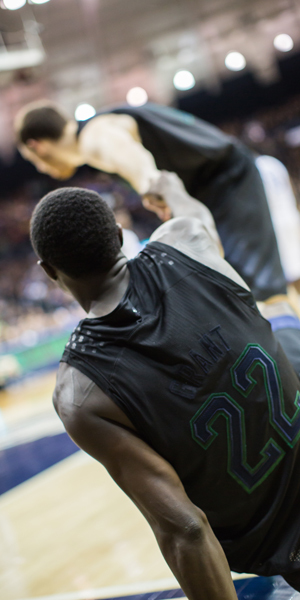
This media coverage of Golson and Grant seems to be in line with the majority of the Notre Dame community’s reaction to their returns. Their past transgressions appear to have been largely forgiven and forgotten.
Sophomore business major Tom Moster is excited to see Golson and Grant return.
“It’s really exciting,” he says. “They’re both really fun players to watch. I think everyone’s really happy to see them back. The games will be more entertaining and the teams will be more dynamic with them out there.”
The response of many members of the community makes the comparison to the Prodigal Son seem applicable. Golson and Grant have been welcomed back into a family after their absence and transgressions. Notre Dame theology professor Father Paul Kollman is not sure, however, that the story of the Prodigal Son is completely analogous to Golson and Grant’s returns. He argues that the father’s forgiveness in the Prodigal Son story is not something the Notre Dame community can provide to Golson and Grant.
“To think that we ought to ‘forgive them’ seems to me confer on the Notre Dame community a sense of entitlement that makes me very worried,” he says. “We can rejoice and suffer with our athletic programs due to our loyalties, but we ought to be wary of thinking that student-athletes ‘owe’ us anything.”
Despite the raucous fan support continuously present at sporting events, some students harbor resentment towards the way that athletes and athletics are treated at Notre Dame. Junior political science and Chinese major Stephen Wagner takes exception to the higher priority the university seems to give to athletes at a school renowned for its academic excellence. “I guess I just don’t appreciate the amount of money that we spend on athletics—the stadium renovation, new turf, new uniforms everything,” he says. “For a top-tier academic school, I wish the university invested more of their resources in the average student.”
Perhaps it is this underlying bitterness towards the resources that student-athletes receive that makes other students feel like they “owe” them something when they step on the field. It may be easy for a student to think that if student-athletes are receiving additional resources, they need to perform.
Professor Collett is concerned that the recent academic issues encountered by Golson and Grant, as well as the five football players currently under investigation, could strengthen the stereotype of the “dumb jock” athlete.
“We already have on this campus a problem with stereotypes of athletes…that these students aren’t as smart or that they don’t work as hard or the rules don’t apply to them,” he says. “It could just be really dangerous if these kinds of things continue to come out and make people wonder about the athletes, do they belong here?”
The Wall Street Journal recently addressed this issue in an article titled “Is Notre Dame Football Too Demanding?” The article says that according to former Notre Dame players and administrators, “the quantitative academic standards required for football players have remained the same since at least the 1970’s,” including class and GPA requirements.
Notre Dame President Rev. John I. Jenkins, C.S.C. has strongly denied that the university has relaxed its admission standards or changed its admission criteria. Don Bishop, Notre Dame’s head of admissions, told The Wall Street Journal that Notre Dame does not have minimum admission standards for grades and test scores, adding, “No one is admitted without providing evidence of a high-school performance that demonstrates that he or she can be successful at Notre Dame.”
Like Grant and Golson, former Notre Dame basketball player Kyle McAlarney faced a suspension during his time at Notre Dame. In December 2006, during McAlarney’s sophomore year, he was arrested for marijuana possession during a traffic stop and was ultimately suspended for the spring semester. He had numerous opportunities to play at different universities the following season, but instead chose to return to Notre Dame at the urging of head coach Mike Brey. McAlarney went on to set Notre Damend’s single-season three-point record in back-to-back seasons and was named a captain as a senior.
McAlarney’s personal odyssey has convinced him that Notre Dame is a place where everyone can thrive. On Aug. 16, he tweeted, “Hate it when I hear @NotreDame ‘isn’t for everyone’ I’m a walking example that it indeed is.” Asked to elaborate on the tweet, McAlarney clarified his feelings.
“If somehow I can make it [at Notre Dame], play basketball there, graduate, come back from suspension, then I’m positive there are way more stories like mine, where someone, athlete or not, exceeded expectations people had for them and graduated from Notre Dame,” he says.
“Just because Notre Dame holds everyone to a high standard...does that mean it’s not for everyone? No, it is... It is a place that can and will transform you. At some point you will have a hardship there, whether an athlete or not, in the media or not. If you let it, Notre Dame will help you see through it.”
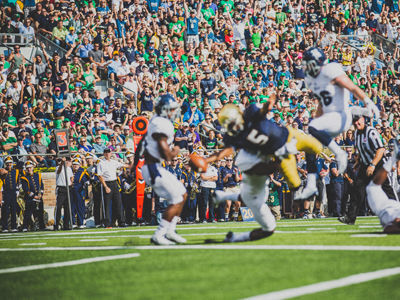
The situation that has unfolded at Notre Dame has been truly unique. Football and basketball are the two most popular sports at the university, and the two highest-profile athletes in these sports were suspended for comprable lengths of time. With such similar situations, it is unsurprising that Golson and Grant have stayed in contact throughout the process. Grant indicated that he has exchanged text messages with Golson encouraging him during football season and has drawn motivation from Golson’s success in his first few games back.
At the end of the “Jerian Grant Returns” WatchND feature, Coach Brey gives a description of the unique ways in which Notre Dame can help these young men grow.
“We lost two very high profile athletes to academic matters in the last year, and I’ve had so many people say ‘God, that’s a tough place. Can they change that rule? Maybe they should do something else?’ I say ‘Whoa whoa whoa hold on a second. That’s who we are at ND, and we’re really proud of it,’” Brey says in the feature.
“I think it speaks volumes to the mission of this place, and our commitment to educating the total person,” he says. “We’re not using them as athletes. If we were, both those guys would have been around and maybe only would’ve been suspended a game or two. I love our mission and our philosophy, and our guys understand and hear. I think both young men that have come back are great stories and will be great ambassadors for us.”
McAlarney added to Brey’s explanation. “They are the faces, role models of that community…The message in all of it though, is that you graduate from ND, a much much better man,” he says.
Notre Dame’s so-called prodigal sons may not have ever needed forgiveness from the Notre Dame community. They paid the price for their transgressions, which to many, now seem in the distant past.
Indeed, their return to school this fall has seen more celebration than censure. It is as if these sons of Notre Dame have returned home